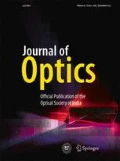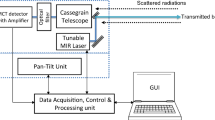Abstract
Lidar (Light Detection And Ranging) is a remote sensing tool of great practical importance in environmental monitoring sciences. As an active remote sensing instrument, lidar provides vertical profiles of aerosol layers and atmospheric temperatures. The effective range and data reliability of lidar is often limited by various noises. Signal processing for lidar applications involves highly nonlinear models and consequently nonlinear filtering as the backscattered signal follows log-linear form. Denoising of the signal is essential for reducing random unwanted variations of the signal, in order to get the significance of the signal as much as possible. In this work, various denoising methods are applied to the signal from Rayleigh receiver of lidar at National Atmospheric Research Laboratory (NARL), Gadanki (13.8°N, 79.2°E) near Tirupati, India. Denoising methods such as Moving Average method, Wavelet and Empirical Mode Decomposition (EMD) method are considered and compared in this work. The Signal to Noise Ratio (SNR), temperature profiles and statistical standard temperature errors are obtained using denoised signals. It is found that EMD gives better SNRs than other denoising methods. The statistical standard temperature error obtained using EMD denoised signal and the original signal are compared and the EMD method is found to reduce temperature errors at higher ranges better than conventional method.








Similar content being viewed by others
References
Argall PS, Sica RJ. Lidar basics.
Sun B-Y, Huang D-S, Fang H-T. Lidar signal denoising using least—squares support vector machine. IEEE Signal Process Lett. 2005;12(2).
Lerkvarnyu S, Deijhan K, Cheevasuvit F. Moving average method for time series lidar data. ACRS. 1998.
Reddy TS, Reddy GR, Varadajan GR. Noise reduction in LIDAR signal using wavelets. Int J Eng Tech. 2009;2(1).
S. Wu, Z. Liu, B. Liu, Enhancement of lidar backscatters signal—to-noise ratio using empirical mode decomposition method. Opt Commun 267, 137––144 (2009)
Li J, Gong W, Ma Y. Atmospheric lidar noise reduction based on ensemble empirical mode decomposition. Int Arch Photogr Remote Sensing Spatial Inf Sci. 2012;XXXIX-B8, 2012, XXII ISPRS Congress, Melbourne, Australia.
W. Gong, J. Li, F. Mao, J. Zhang, Comparison of simultaneous signals obtained from a dual field-of-view lidar and its application to noise reduction based on empirical mode decomposition. Chin Opt Lett COL 9(5), 050101 (2011)
Kumar YB, Raghunath K, Kumar VS, Rao PB, Jain AR. “Indo-Japanese Lidar: system description and data processing”. Radar Symp India 1999
H. Fang, D. Huang, Noise reduction in Lidar signal based on discrete wavelet transform. Opt Commun 233, 67–76 (2004)
Kim D. Introduction to EMD (empirical mode decomposition) with application to a scientific data. 2006.
Z. Liu, N. Zhang, R. Wang, J. Zhu, Doppler wind lidar data acquisition system and data analysis by empirical mode decomposition method. Opt Eng 46(2), 026001 (2007)
A. Hauchecorne, M.-L. Chanin, Density and temperature profiles obtained by Lidar between 35 and 70 km. Geophys Res Lett 7(8), 565–568 (1980)
Author information
Authors and Affiliations
Corresponding author
Rights and permissions
About this article
Cite this article
Sarvani, M., Raghunath, K. & Rao, S.V.B. Lidar signal denoising methods- application to NARL Rayleigh lidar. J Opt 44, 164–171 (2015). https://doi.org/10.1007/s12596-015-0247-8
Received:
Accepted:
Published:
Issue Date:
DOI: https://doi.org/10.1007/s12596-015-0247-8




